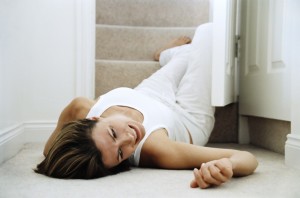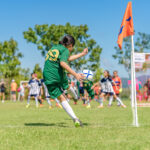
14 Jul Part 2: Are You at Risk of Falling?
What Factors Play a Role in Falling?
In Part 1, we discussed the impact falls can have on our lives, the systems that help with our balance, and self-assessment strategies to determine our risk or a loved one’s risk for falls. In this part of the series, we will address specific risk factors for falls and discuss how the interaction of many factors puts people at risk.
Most falls people experience are not due to just one thing such as weakness or “losing our balance”. Up to 70% of falls are due to interacting risk factors such as strength deficits, balance deficits, mobility deficits, medication mismanagement, and vision impairments. Lower extremity strength is probably the most obvious factor for most people who fall. It is apparent for most of us when we are not able to stand up from a chair on our own or it is difficult to climb up or down stairs without assistance. A sedentary lifestyle can also lead to loss of leg strength which can increase our fall risk.
There are also many factors that affect our balance that contribute to our fall risk. Numbness in our feet, light-headedness or vertigo (i.e. room spinning), and a sedentary lifestyle all affect our body’s ability to recognize where we are in relation to our environment which compromises our ability to prevent falling. A loss of strength coupled with any of these balance related factors can lead to a very challenging situation especially for older individuals.
It has also been shown that mobility deficits, such as walking slowly, leads to an increased fall risk. A sedentary lifestyle coupled with social isolation and possible depression can affect a person’s desire to be more active. As their activity levels decrease, their strength, balance, and mobility also decrease which can quickly result in further health problems and increased fall risk.
Unfortunately, many of the medical treatments we consider necessary also increases our fall risk. Use of multiple medications, especially sedatives, antidepressants, and antihypertensives, has been shown to increase the risk of falls, and taking as few as 5 medications for health-related conditions has been shown to increase fall risk in the elderly. Another common problem with medications is misuse or overuse. Missing a dose or accidently taking a “double dose” of a medicine compromises the effectiveness of the medication and can lead to undesirable side-effects including dizziness, lightheadedness, or unpredictable reactions for the person, all of which increases the risk of falls. Even eye care and glasses can be problematic if not properly managed. Wearing multifocal lenses can compromise the ability to effectively navigate stairs or curbs which can lead to a fall, and improper lens prescription can affect vision and subsequently compromise your balance when walking and moving around.
In addition to the physical or medical issues discussed above, environmental factors also play a role in falls. Throw rugs, lack of appropriate hand rails on stairs or around toilets, clutter on the floor at home, and icy or slippery surfaces due to snow or rain all affect our ability to safely move and walk without risking a fall.
As you can see, there are a number of factors that can lead to falls. It is infrequent that only one of these factors is the reason someone falls, and it is common that many factors interact to cause a compromise in strength, balance, or mobility which then puts the person at risk for falling. Therefore, it is important for us to identify as many of these issues prior to someone we care about falling. In Part 3 in this series on falls, we will discuss specifics on how to prevent falls and who needs to be involved in this process for the most effective fall prevention plan for our loved ones.





